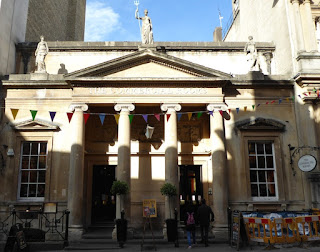Monday, October 17, 2016
Bristol
Monument of commerce
Corn Street is the heart of old commercial Bristol. It’s where the Exchange is, and it’s full of old bank buildings and the offices or former offices of insurance companies. Some of the buildings have statuary celebrating Bristol’s roots in exploration and trade (I’ve posted one staggeringly ornamental bank building before*).
Here’s another of these mercantile structures, the Commercial Rooms, built in 1809–11 as a club for merchants. The façade can certainly hold its own – the big Ionic portico and side windows hark back to the Palladian proportions of the previous century.† However, the Commercial Rooms’ impact comes just as much from the sculpture – the three figures at the top are personifications of Commerce, Navigation, and the city of Bristol itself.
Inside, there’s a big room with a very striking domed ceiling. This consists of a shallow dome at the top, raised on slender caryatids (in between which are glazed panels), themselves supported on pendentives. The pendentives are the triangular bits that enable the circular dome to fit on top of a square aperture. It’s altogether an elegant design, lending the interior both grandeur and light. I imagine it would originally have been painted in more restrained colours, pastel shades perhaps.
The Commercial Rooms is no longer a club for merchants.§ It’s a pub now, and all can enjoy its striking interior. I’m glad I had a look inside.
- - - - -
*My post is here.
†The Pevsner city guide to Bristol notes that the architect, C A Busby, drew on a couple of slightly earlier buildings (the Liverpool Lyceum, 1802 and the Manchester Portico Library, 1802–6) for some of these effects – the library certainly has a big portico and a domed ceiling inside. The guide points to Sir John Soane’s domed Consols Transfer Office in the Bank of England (1798–9) as one source for the interior dome.
§ It’s now a Wetherspoon’s and there’s more information here.
Subscribe to:
Post Comments (Atom)





4 comments:
I've got a strong feeling I've been in here when it was a club. As it was one of many Bristolian lunches I was involved in in the 1980s I could of course be mistaken. But one thing I either remembered or dreamt-up was that there was some sort of weathervane up on the wall to help merchants guess when their ships might arrive. Presumably if it was a strong easterly they'd order another bottle of port.
Peter: Yes, that's the place. I didn't know about the weathervane until, getting back home and reading about the building I'd just seen, I came across a reference to it. So now of course I'll have to go back and have another look.
Congratulations again on getting a shot of the whole building in the narrow confines of Corn Street! A truly lovely building, fortunately free of the Greek and Minimalist tendencies of the period. Stick to Roman, folks!
It is interesting that merchants must have poured a ton of money into this facility, built in 1809–11 as a social club for themselves. Now I am sure that they talked business in the club and didn't just cosy up in leather seats with whiskeys in hand. However it was a social club primarily and not a bank, insurance office, shipping company or government department.
Business men certainly knew how to look after themselves back then!
Post a Comment